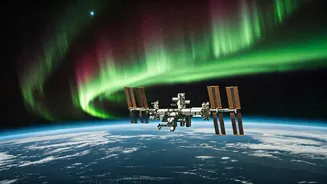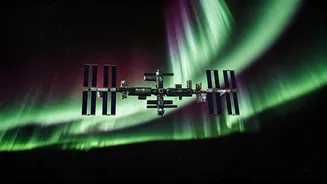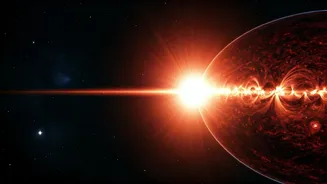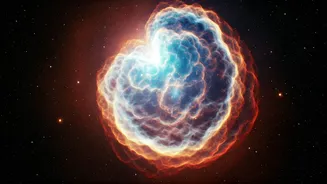Solar Flare Unleashed
The occurrence of the solar storm began with a powerful eruption on the Sun's surface, resulting in a series of coronal mass ejections (CMEs). These CMEs are
vast expulsions of plasma and magnetic fields from the Sun's corona, capable of traveling through space at incredibly high speeds. When these ejections reach Earth, they can interact with the planet's magnetic field, leading to various effects, including auroras. The scale of the recent CMEs was significant, indicating the storm's intensity. The solar activity caused the formation of magnificent auroras, visible in different parts of the world, offering an extraordinary celestial display. However, beyond the visual beauty, the storm posed a notable threat to technological infrastructure, including satellites and power grids, highlighting the need for vigilance and preparedness in space weather forecasting and management.
ISS Crew's Response
In response to the escalating solar storm, the crew of the ISS took swift action to ensure their safety. They were instructed to retreat to areas of the station that provided greater protection from the radiation associated with such events. These protective zones within the ISS are specifically designed to shield astronauts from the harmful effects of solar radiation. The primary objective was to minimize exposure to radiation, thereby mitigating potential health risks. This protective measure highlights the importance of space weather monitoring and its influence on astronaut safety protocols. This incident demonstrated the real-world implications of understanding and preparing for extreme space weather events. It emphasized the need for ongoing advancements in forecasting and mitigating the risks posed by solar storms to space missions and the astronauts on board.
Auroras Across Earth
As the solar storm intensified, it triggered spectacular auroras across different regions of Earth. These auroras, known as the aurora borealis in the northern hemisphere and the aurora australis in the southern hemisphere, are visual representations of the interaction between charged particles from the sun and Earth's atmosphere. The solar storm's intensity led to more frequent and vibrant auroras, offering remarkable displays in the skies. Observers worldwide captured images of these auroras, showcasing the storm's reach and impact. The auroras demonstrated the dynamic nature of space weather and the interconnectedness of the Sun and Earth. The beauty of these light displays serves as a reminder of the scientific phenomena continuously occurring in space and their impact on our planet. Furthermore, these events highlight the significance of space weather research and its importance for both our understanding of the universe and technological infrastructure.
Space Weather Impact
Solar storms have the potential to disrupt technologies and systems that rely on satellites, and power grids. The high-energy particles emitted during solar storms can interfere with satellite operations, potentially leading to communication failures, navigation problems, and even damage to spacecraft. Similarly, the Earth's magnetic field fluctuations caused by these storms can induce currents in power grids, leading to blackouts and other operational disruptions. Recognizing these hazards, researchers are continuously developing better prediction models for space weather. These models aim to forecast solar activity and enable timely alerts for potential disruptions. By closely monitoring solar activity and refining predictive capabilities, it becomes possible to safeguard important infrastructure and prepare for possible effects. Ongoing research provides crucial insights into how solar storms affect technology and fosters more effective mitigation strategies.
Ongoing Research Efforts
Significant advances in space weather forecasting and study are underway. Scientists are utilizing satellites and ground-based observatories to continually monitor the Sun's activity. These tools gather information on solar flares, CMEs, and other events that could affect Earth. The data collected facilitates the development of improved models, aiding in the prediction of space weather events with greater precision. International collaborations and data-sharing networks facilitate more in-depth analyses and understanding of space weather. These joint efforts ensure comprehensive monitoring capabilities and allow experts from diverse fields to contribute their expertise. Continuous monitoring and research contribute to improving preparedness and resilience against extreme space weather events. These efforts demonstrate a collective commitment to protecting our technological infrastructure and ensuring the safety of those in space and on Earth.













